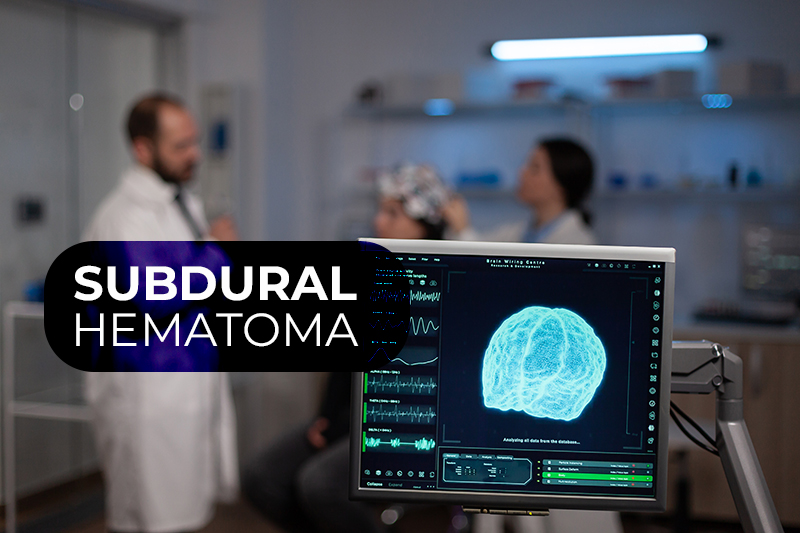Head injury is a matter of serious concern that requires medical attention. A person suffering even a minor head injury may not experience any specific issues in the beginning, but internal bleeding can occur over time, causing serious consequences like brain damage and even death. Subdural hematoma (also called a subdural hemorrhage) is a type of internal bleeding that occurs when a vein below the skull ruptures and causes bleeding. The bleeding can increase pressure on the brain, resulting in serious complications. If undiagnosed and untreated, subdural hematomas can lead to chronic health problems, unconsciousness, and even death. Correct diagnostic processes to identify the condition is essential develop an appropriate treatment plan. Physicians can rely on medical billing and coding outsourcing to report services correctly and ensure clean claims.
While head injury is the most common reason for subdural hematoma, the condition can also occur due to other medical conditions. Subdural hematoma can be either acute or chronic. When the condition is caused by a severe head injury, it is considered acute. On the other hand, chronic cases occur due to repeated and mild head injuries where the amount of bleeding is smaller and occurs more slowly. Chronic cases are more common in older adults due to increased frequency of falls in this group. The extent and severity of the injury determines how subdural hematoma will be categorized. The symptoms of subdural hematoma varies from person to person and can include severe headache, seizures, slurred speech, loss of consciousness, vision problems, and weakness.
Diagnosis
Initial diagnosis will involve a physical and neurological examination to check blood pressure, pulse, reflexes, and balance and vision. The neurologist will check blood pressure and heart rate for evidence of internal bleeding. Diagnostic tests like computed tomography (CT) or magnetic resonance imaging (MRI) scans may be ordered to check for signs of blood clotting in the brain, skull, veins, and other blood vessels.
ICD-10 Codes for Subdural Hematoma
ICD-10 code S06.5 denotes – Traumatic subdural hemorrhage.S06.5 is a billable/specific ICD-10-CM code that can be used on the medical claim to indicate a diagnosis for reimbursement purposes.
- S06.5 Traumatic subdural hemorrhage
- S06.5X Traumatic subdural hemorrhage
- S06.5X0 Traumatic subdural hemorrhage without loss of consciousness
- S06.5X0A …… initial encounter
- S06.5X0D …… subsequent encounter
- S06.5X0S …… sequela
- S06.5X1 Traumatic subdural hemorrhage with loss of consciousness of 30 minutes or less
- S06.5X1A …… initial encounter
- S06.5X1D …… subsequent encounter
- S06.5X1S …… sequela
- S06.5X2 Traumatic subdural hemorrhage with loss of consciousness of 31 minutes to 59 minutes
- S06.5X2A …… initial encounter
- S06.5X2D …… subsequent encounter
- S06.5X2S …… sequela
- S06.5X3 Traumatic subdural hemorrhage with loss of consciousness of 1 hour to 5 hours 59 minutes
- S06.5X3A …… initial encounter
- S06.5X3D …… subsequent encounter
- S06.5X3S …… sequela
- S06.5X4 Traumatic subdural hemorrhage with loss of consciousness of 6 hours to 24 hours
- S06.5X4A …… initial encounter
- S06.5X4D …… subsequent encounter
- S06.5X4S …… sequela
- S06.5X5 Traumatic subdural hemorrhage with loss of consciousness greater than 24 hours with return to pre-existing conscious level
- S06.5X5A …… initial encounter
- S06.5X5D …… subsequent encounter
- S06.5X5S …… sequela
- S06.5X6 Traumatic subdural hemorrhage with loss of consciousness greater than 24 hours without return to pre-existing conscious level with patient surviving
- S06.5X6A …… initial encounter
- S06.5X6D …… subsequent encounter
- S06.5X6S …… sequela
- S06.5X7 Traumatic subdural hemorrhage with loss of consciousness of any duration with death due to brain injury before regaining consciousness
- S06.5X7A …… initial encounter
- S06.5X8 Traumatic subdural hemorrhage with loss of consciousness of any duration with death due to other cause before regaining consciousness
- S06.5X8A …… initial encounter
- S06.5XA Traumatic subdural hemorrhage with loss of consciousness status unknown
- S06.5XAA …… initial encounter
- S06.5XAD …… subsequent encounter
- S06.5XAS …… sequela
- S06.5X9 Traumatic subdural hemorrhage with loss of consciousness of unspecified duration
- S06.5X9A …… initial encounter
- S06.5X9D …… subsequent encounter
- S06.5X9S …… sequela
Treatment
Treatment options for subdural hemorrhage will depend on the type and severity of injury. Minor cases of subdural hematomas will be closely monitored to see if they will heal without an operation. Chronic cases will require surgery. Surgical options include craniotomy and burr hole surgery.
CPT Codes
- 61105 Twist drill hole for subdural or ventricular puncture
- 61108 Twist drill hole(s) for subdural, intracerebral, or ventricular puncture; for evacuation and/ or drainage of subdural hematoma
- 61150 Burr hole(s) or trephine; with drainage of brain abscess or cyst
- 61151 Burr hole(s) or trephine; with subsequent tapping (aspiration) of intracranial abscess or cyst
- 61154 Burr hole(s); with evacuation and/or drainage of hematoma, extradural or subdural
- 61156 Burr hole(s); with aspiration of hematoma or cyst, intracerebral
- 61312 Craniectomy or craniotomy for evacuation of hematoma, supratentorial; extradural or subdural
- 61313 Craniectomy or craniotomy for evacuation of hematoma, supratentorial; intracerebral
- 61314 Craniectomy or craniotomy for evacuation of hematoma, infratentorial; extraduralor subdural
- 61315 Craniectomy or craniotomy for evacuation of hematoma, infratentorial; intracerebellar
- 61781 Stereotactic computer-assisted (navigational) procedure; cranial, intradural(List separately in addition to code for primary procedure)
Neurosurgery medical coding can be challenging. Neurosurgeons and neurologists need to ensure that claims are submitted with the correct medical codes. Medical billing and coding companies can provide the support physicians are looking for. Professional medical coders stay up to date with coding changes, billing guidelines, and payer rules and can help physicians ensure submit accurate claims for maximum reimbursement.




